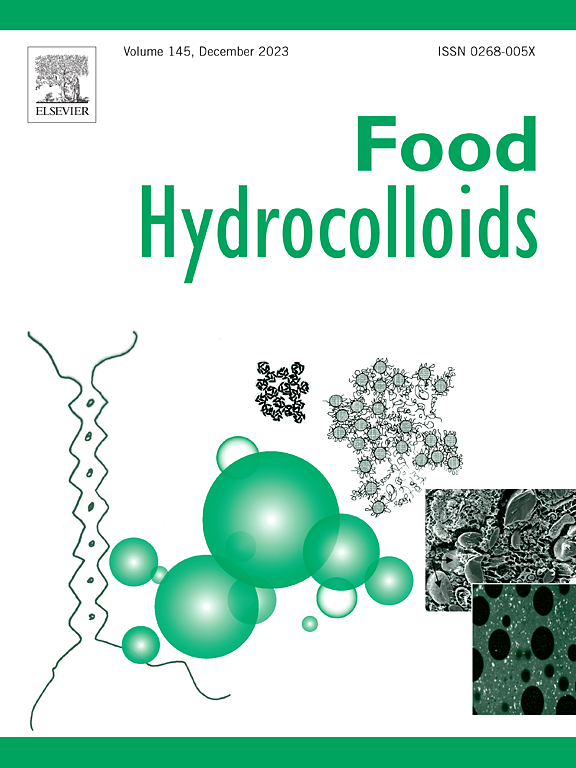Effect of preheating-induced structural changes of mung bean starch and protein on the phase behavior, physicochemical properties, and digestibility of composite hydrogels
IF 11
1区 农林科学
Q1 CHEMISTRY, APPLIED
引用次数: 0
Abstract
Mung bean starch (MBS) and mung bean protein (MBP) were preheated at different moisture contents (20–80 %) to create biopolymers with different characteristics. For MBS, preheating led to different degrees of gelatinization, whereas for MBP it led to different degrees of protein aggregation and surface hydrophobicity. Pre-gelatinized starch formed junctions with double helix structures arranged in the amorphous region and the particle size increased. As the degrees of gelatinization of starch increased, the composite hydrogels changed their structure from having a starch-rich continuous phase, to a bicontinuous network, to having a protein-rich continuous phase. Moreover, the mechanical strength and water holding properties of the composite hydrogels decreased and their starch digestibility increased. This effect was mainly attributed to the disruption of the starch structure and the formation of a more open gel network, which facilitated the ability of the amylases to hydrolyze the starch molecules. Preheating the protein did not have as large an impact on the microstructure of the composite hydrogels as the starch. However, the presence of the MBPs with higher surface hydrophobicity prompted its interaction with starch, resulting in a significantly softer gel with slower digestion, which was attributed to their stronger ability to interfere with crosslinking between the starch molecules. Correlation and principal component analysis indicated starch and protein structures had significant internal correlations. Starch structure dominated, while protein structure modulated gel properties. Preheating-induced structural changes in starch and protein enhance composite gel diversity.

预热诱导的绿豆淀粉和蛋白质结构变化对复合水凝胶相行为、理化性质和消化率的影响
对绿豆淀粉(MBS)和绿豆蛋白(MBP)在不同含水量(20 ~ 80%)下进行预热,制备出不同特性的生物聚合物。对于MBS,预热导致不同程度的糊化,而对于MBP,预热导致不同程度的蛋白质聚集和表面疏水性。预糊化淀粉在非晶区形成双螺旋结构的结,颗粒尺寸增大。随着淀粉糊化程度的增加,复合水凝胶的结构由富含淀粉的连续相变为双连续网络,再变为富含蛋白质的连续相。复合水凝胶的机械强度和持水性降低,淀粉消化率提高。这种影响主要是由于淀粉结构的破坏和形成更开放的凝胶网络,这促进了淀粉酶水解淀粉分子的能力。对蛋白质的预热对复合水凝胶的微观结构的影响不如对淀粉的影响大。然而,具有更高表面疏水性的MBPs的存在促使其与淀粉相互作用,导致凝胶明显更软,消化速度更慢,这是由于它们干扰淀粉分子之间交联的能力更强。相关分析和主成分分析表明,淀粉和蛋白质结构具有显著的内在相关性。淀粉结构占主导地位,蛋白质结构调节凝胶性质。预热引起的淀粉和蛋白质结构变化增强了复合凝胶的多样性。
本文章由计算机程序翻译,如有差异,请以英文原文为准。
求助全文
约1分钟内获得全文
求助全文
来源期刊

Food Hydrocolloids
工程技术-食品科技
CiteScore
19.90
自引率
14.00%
发文量
871
审稿时长
37 days
期刊介绍:
Food Hydrocolloids publishes original and innovative research focused on the characterization, functional properties, and applications of hydrocolloid materials used in food products. These hydrocolloids, defined as polysaccharides and proteins of commercial importance, are added to control aspects such as texture, stability, rheology, and sensory properties. The research's primary emphasis should be on the hydrocolloids themselves, with thorough descriptions of their source, nature, and physicochemical characteristics. Manuscripts are expected to clearly outline specific aims and objectives, include a fundamental discussion of research findings at the molecular level, and address the significance of the results. Studies on hydrocolloids in complex formulations should concentrate on their overall properties and mechanisms of action, while simple formulation development studies may not be considered for publication.
The main areas of interest are:
-Chemical and physicochemical characterisation
Thermal properties including glass transitions and conformational changes-
Rheological properties including viscosity, viscoelastic properties and gelation behaviour-
The influence on organoleptic properties-
Interfacial properties including stabilisation of dispersions, emulsions and foams-
Film forming properties with application to edible films and active packaging-
Encapsulation and controlled release of active compounds-
The influence on health including their role as dietary fibre-
Manipulation of hydrocolloid structure and functionality through chemical, biochemical and physical processes-
New hydrocolloids and hydrocolloid sources of commercial potential.
The Journal also publishes Review articles that provide an overview of the latest developments in topics of specific interest to researchers in this field of activity.
 求助内容:
求助内容: 应助结果提醒方式:
应助结果提醒方式:


